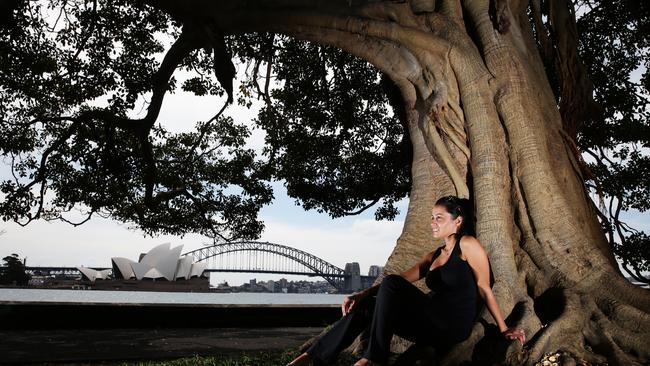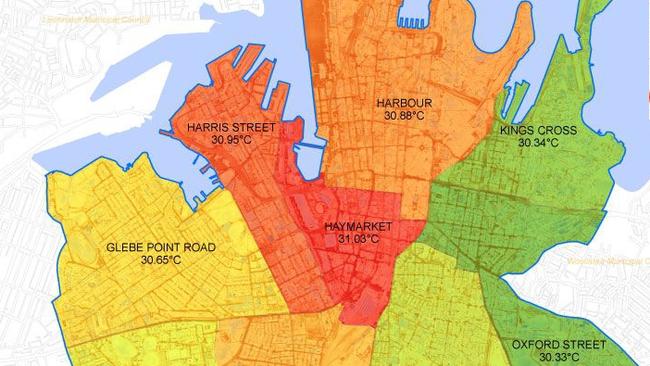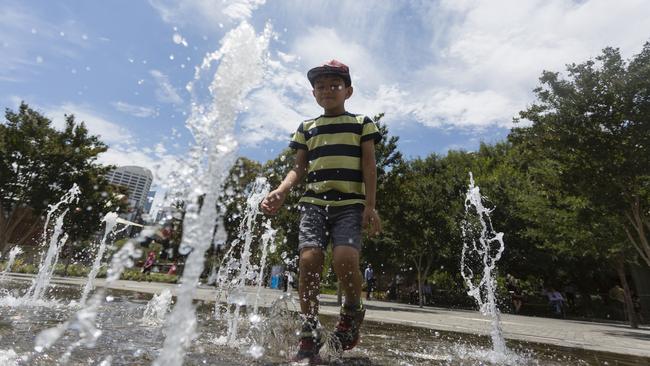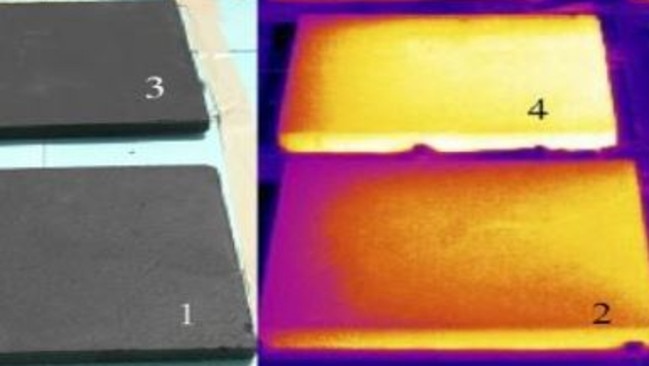‘Heat dome’ surrounding Australian CBDs leave suburbs to scorch
THERE is a good reason why certain suburbs are hotter than others. Thankfully, there’s a simple way to cool us all down.
ASK any Sydneysider west of Central station and they will tell you that if it’s warm in the CBD it’ll be roasting out west.
Last weekend was no exception with temperatures in Penrith, in the city’s west, peaking at 47.3C while the area by the Harbour Bridge topped out more than five degrees cooler.
But far from this being simply a natural quirk of geography, human interference has actually exacerbated the boiling temperatures in our inland suburbs, experts say, by creating a “heat dome” blocking cooler air.
And often, it’s less affluent areas that feel the worst of the heat while richer enclaves enjoy an altogether more comfortable day.
Climate researchers have said some relatively easy changes, as simple as installing fountains, could bring the mercury down in our scorched suburbs.

Much of the difference in temperature between costal and inland areas is due to a combination of desert-warmed air from the interior hitting the west while cooling sea breezes fail to penetrate into suburbia — be that Penrith in Sydney or Ipswich in Brisbane. More of a puzzle is why those sea breezes don’t penetrate very far.
Many of our cities are afflicted by what’s known as the “urban heat island effect”. This is where urban areas are significantly hotter than their rural surrounds.
Mattheos Santamouris, a professor of high performance architecture at UNSW, said the temperature difference was because of the materials used on roads and in buildings.
“There’s much more solar radiation absorbing materials in built-up areas, such as black asphalt and concrete, lots of anthropogenic heat from cars, airconditioning and industry and less greenery and water, and this increases the temperature and has a serious impact on energy consumption, productivity, health and morbidity,” he said.
The data is stark. Annually, coastal Sydney sees five heat-related deaths per 100,000 people while the city’s west sees 14 per 100,000.

In Darwin, Prof Santamouris measured road surface temperatures in the CBD and showed they could reach as high as 70C which, in turn, could raise the ambient temperature by as much as three degrees.
One mooted solution is to plant more trees to cool streets, provide shade and bring the air temperature down.
Research published in September by RMIT and the University of Western Australia showed vegetation equivalent to the size of Brisbane had been lost in our cities over the last three years.
This loss of tree canopy could see temperatures spike by up to 10C. Disturbingly, the vegetation loss was concentrated in less affluent areas.
Associate Professor Marco Amati from RMIT’s Centre for Urban Research, said
as areas lose vegetation they act like “heat sponges” sucking in warmth.

“Our study showed areas identified as less affluent are at risk of having urban hot spots that are more than 10 degrees higher than those found in wealthier areas.”
Last year, Dr Brent Jacobs, research director at the Institute of Sustainable Futures at the University of Technology Sydney, said temperatures were rising faster in western Sydney than in eastern areas due to climate change and urban development.
“Especially in western Sydney, we were able to make the close association that high-density housing developments had cleared land and lacked tree cover, and dark roads were corridors where heat just couldn’t escape,” he said.

But Prof Santamouris told news.com.au planting trees could only go so far in cooling suburbs. The real reason Penrith was so hot lay 54km east — at Sydney’s CBD. The urban heat island of the inner city was effectively blocking the cooler air from reaching the burbs.
“The CBD, because of its high temperature, is like a wall that stops the sea breeze in its tracks. Over Sydney’s CBD is a heat dome because of the high density of concrete and asphalt.
“If we want to cool western Sydney and demolish this wall, we need to cool the CBD first.”
“Even if you changed western Sydney into a green park (full of trees) that would only reduce the temperature by 1.5C (without the sea winds),” he said.
The City of Sydney is making efforts to cool down the CBD. Some of its major new commercial and residential developments, such as Central Park and Green Square, are at the front of the pack environmentally. In terms of tree cover, the city is bucking the trend with 3.6 per cent more trees in 2016 than in 2009.

Last month, Sydney Lord Mayor Clover Moore said trees are “our greatest weapon in the battle against the urban heat island effect”.
But it could be a losing battle, she said. “Although we’ve planted 7950 street trees since 2008, we face formidable challenges from major state infrastructure projects, particularly the WestConnex (motorway project),” she told Central.
Aside from planting more vegetation, the council has reclad a street with a paler bitumen. “Lighter-coloured surfaces do not generally absorb as much light, or retain as much heat as dark surfaces and therefore have the potential to reduce temperatures, resulting in lower energy bills for surrounding buildings, and improve road strength,” council said of the project.

Darwin has gone one step further and buried one of its biggest CBD car parks to minimise its effect on the ambient temperature.
Prof Santamouris said there is one thing interior suburbs often lack that could help to cool them down — water.
“Water is one of the best technologies we can use. We need to have it everywhere.”
Be that fountains, lakes, sprinklers, water curtains or ponds, research by UNSW showed water combined with cooler materials could bring ambient temperatures down by as much as 10 degrees is some specific areas.
This needed to be combined with higher quality housing that was more heatproof so the need to use energy sapping airconditioners was lessened, he said.

For its part, Penrith City Council has a “cooling the city” strategy in place. The city has identified 12,000 sites that are “particularly challenging in terms of urban heat”. The council plans to plant 100,000 trees by August 2018, has integrated heat reduction into the design of new community spaces and is even trialling heat-busting bus stops. The aim is to try to ensure 47C days are the exception, not the norm.
But Prof Santamouris said all the plants, pale pavings and ponds in the world won’t make Penrith cooler if the climate continues to warm.
“The problem with Sydney is global — it’s climate change and the number of days with high temperatures is only going to increase.”




